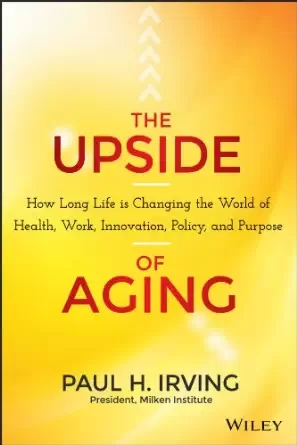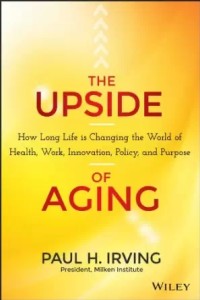
Reviewed by Barbara Morris
 Recently on C-SPAN I watched Paul H. Irving talk about “The Upside of Aging” and what I heard had the electrons in my brain doing a happy dance. My feet were happy, too. I was on my treadmill and they wanted to do a happy dance as well. I was thinking, “This guy is right on! He gets it!” Even before he finished speaking I jumped off my treadmill, boogied over to my computer, and ordered his book titled, of course, The Upside of Aging.
Recently on C-SPAN I watched Paul H. Irving talk about “The Upside of Aging” and what I heard had the electrons in my brain doing a happy dance. My feet were happy, too. I was on my treadmill and they wanted to do a happy dance as well. I was thinking, “This guy is right on! He gets it!” Even before he finished speaking I jumped off my treadmill, boogied over to my computer, and ordered his book titled, of course, The Upside of Aging.
I was disappointed on two counts: First, Irving’s name was on the book cover but each chapter was provided by someone else. The other disappointment was with content early on in the book.
Chapter 2, “Personalized Aging: One Size Doesn’t Fit All” by Pinchas Cohen, Dean USC Davis School of Gerontology was promising until he started discussing nutrigenomics, which is the scientific study of how genes and nutrition interact. Simplified, this is the way nutrigenomics works:
You have a blood test to identify specific gene variants. Any particular variant might predict a need for a higher level of one specific vitamin, or may predict whether you could benefit from a specific intervention, like lowering triglycerides. The information from the test allows a person to focus on dietary interventions that actually will help. (Guess what. Predicting the need for a specific vitamin or dietary intervention with a blood test is already possible. Read on.)
Dr. Cohen explains:
“As exciting as all this is, it is important to note that nutrigenomics is not ready for immediate translation to the community. We do not yet have the mature tools and the large-scale data from prospective clinical studies to demonstrate beyond doubt the benefits of a particular dietary intervention in individuals with a certain genetic makeup.
My goal and that of many in the gerontology community is to build a consensus around the need for such studies, whose results will offer people a chance to customize their diets to their individual genes and family histories.
Such studies will require years, and large amounts of funds.”
 Got it? It will require years and large amounts of funds to figure out how to determine needed dietary interventions using a comprehensive blood test.
Got it? It will require years and large amounts of funds to figure out how to determine needed dietary interventions using a comprehensive blood test.
This is where Dr. Cohen lost me and made me angry. He goes on,
“Importantly however, despite what we hope is the promise of such research, “clinics” that today already offer nutrigenomics services should be considered as operating outside the boundaries of legitimate medicine, peddling immature and unproven dietary recommendations that have not been clinically validated.”
Excuse me?
My naturopath does, in effect, offer “nutrigenomics” services. A comprehensive blood test three times a year reveals what is going on in my body, and my naturopath’s evaluation of the test results tells me what supplement or dietary changes should be made. If I follow her advice, the next blood test will show whether or not improvement has occurred. In my case, it almost always does. When it doesn’t, it’s usually because I allowed some aspect of my diet to run off the rails.
The reality is, using comprehensive blood tests to determine health status doesn’t, as Dr. Cohen insists, “require years and large amounts of funds.” And it is not operating outside the bounds of legitimate medicine.
Yes, in-depth studies are always helpful but in the meantime, let’s be open-minded and work with what we have, instead of criticizing legitimate help that is already available, valuable and reliable.
Bias, closed-mindedness, and just plain ignorance is alive and well in the elite medical community, to the detriment of the health of the public. Don’t allow it to influence you. Take charge of your health. Find a nutrition oriented naturopath and get a comprehensive blood test. Your naturopath will interpret the results for you and may suggest supplements and/or dietary/lifestyle changes to improve your health. If your insurance won’t pay for the test, you will be a couple of hundred out of pocket, at most. A small price to pay to get a realistic view of the state of your health, and what interventions may be needed.
I have not read beyond the second chapter. As disappointed as I am, I am hopeful authors of other chapters have provided the help and inspiration I assumed would be found after hearing Paul H. Irving’s talk on C-SPAN.
Leave a Reply